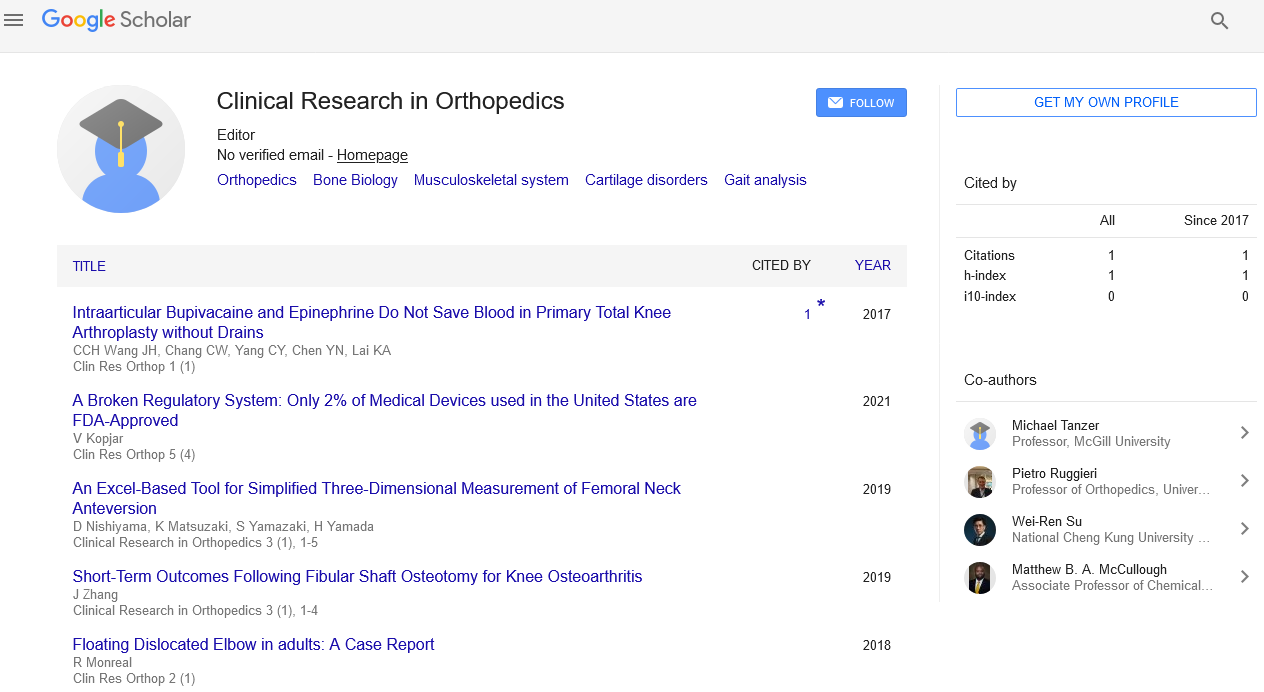Commentary, Clin Res Orthp Vol: 7 Issue: 3
Anterior Cruciate Ligament (ACL) Reconstruction and Rehabilitation Essentials
Balint Narup*
Department of Orthopaedics, University of Gothenburg, Gothenburg, Sweden
*Corresponding Author: Balint Narup
Department of Orthopaedics, University of
Gothenburg, Gothenburg, Sweden
E-mail: narupbalint@gmail.com
Received date: 23 August, 2023, Manuscript No. CRO-23-118345;
Editor assigned date: 25 August, 2023, PreQC No. CRO-23-118345 (PQ);
Reviewed date: 08 September, 2023, QC No. CRO-23-118345;
Revised date: 15 September, 2023, Manuscript No. CRO-23-118345 (R);
Published date: 22 September, 2023 DOI: 10.35248/cro.1000088.
Citation: Narup B (2023) Anterior Cruciate Ligament (ACL) Reconstruction and Rehabilitation Essentials. Clin Res Orthp 7:3.
Description
Anterior Cruciate Ligament (ACL) reconstruction is a common surgical procedure designed to restore knee stability and function following ACL injuries. This article provides a comprehensive overview of ACL injuries, the surgical reconstruction process, rehabilitation, and potential complications. Understanding these aspects is essential for patients, healthcare professionals, and researchers aiming to enhance patient outcomes and reduce the risk of post-operative complications.
The Anterior Cruciate Ligament (ACL) is a crucial structure in the knee joint that stabilizes it by preventing excessive forward movement of the tibia relative to the femur. ACL injuries are common, particularly among athletes and those with active lifestyles. While not all ACL injuries require surgical intervention, ACL reconstruction is often recommended for individuals looking to restore knee stability and function.
ACL injury causes
ACL injuries typically result from non-contact mechanisms such as pivoting, deceleration, and jumping or direct contact to the knee. Athletes, especially those involved in sports that require rapid changes in direction, are at increased risk. Factors contributing to ACL injury risk include gender (women are more prone), anatomical factors, neuromuscular imbalances, and previous ACL injuries.
Indications for ACL reconstruction
The decision to undergo ACL reconstruction depends on various factors, including the individual's activity level, age, and the extent of functional instability. While some individuals can manage without surgery and opt for physical therapy and activity modification, surgical reconstruction is often recommended for athletes and those with persistent instability.
Surgical technique
ACL reconstruction is typically performed arthroscopically, using small incisions and specialized instruments. The torn ACL is replaced with a graft, which can be autograft (patient's tissue) or allograft (donor tissue). Common autograft options include the patellar tendon, hamstring tendons, or quadriceps tendon. The choice of graft depends on individual factors and surgeon preference.
Rehabilitation
Rehabilitation plays a crucial role in the success of ACL reconstruction. It involves a structured program of exercises and activities to regain strength, mobility, and function in the knee. The rehabilitation process typically spans several months, with specific phases to address various aspects of recovery. Physical therapists work closely with patients to ensure a safe and effective recovery.
Potential complications
ACL reconstruction, like any surgical procedure, carries potential complications. Infection, graft failure, persistent instability, loss of motion, and arthrofibrosis are some of the complications that can occur. Careful patient selection, adherence to rehabilitation protocols, and surgical expertise can help reduce the risk of these complications.
The timeline for returning to sports or high-impact activities after ACL reconstruction varies from person to person but typically ranges from six to twelve months. Clearance for return to sports is based on various factors, including functional recovery, strength, stability, and the absence of pain or swelling. Additionally, psychological readiness is an important consideration.
Advances in ACL Reconstruction Over the years, advancements in ACL reconstruction techniques, graft choices, and rehabilitation protocols have improved patient outcomes. Emerging technologies, such as augmented reality, have the potential to further enhance surgical precision and rehabilitation outcomes. Research into biological augmentation and tissue engineering also holds promise for future improvements in ACL reconstruction.
Anterior Cruciate Ligament (ACL) reconstruction is a wellestablished surgical procedure that can effectively restore knee stability and function after ACL injuries. It is particularly valuable for athletes and individuals seeking to return to high-impact activities. However, the success of ACL reconstruction depends on several factors, including appropriate patient selection, surgical expertise, and diligent post-operative rehabilitation. Ongoing research and technological advancements continue to enhance the field, offering promising opportunities to further improve patient outcomes and minimize post-operative complications. Patients considering ACL reconstruction should engage in open discussions with their healthcare providers to make informed decisions regarding their treatment.
 Spanish
Spanish  Chinese
Chinese  Russian
Russian  German
German  French
French  Japanese
Japanese  Portuguese
Portuguese  Hindi
Hindi 